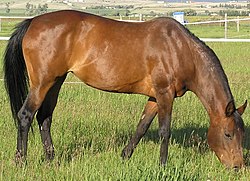Bay (horse)
| Bay | |
|---|---|

A bay mare
|
|
| Variants: | Bright reddish-brown (A) to dark shades influenced by sooty or Seal brown At, wildtype A+ |
| Genotype | |
| Base color: | Black (E) |
| Modifying genes: | agouti gene (A) |
| Description: | reddish-brown body coat with black point coloration |
| Phenotype | |
| Body: | reddish-brown |
| Head and Legs: | Black |
| Mane and tail: | Black |
| Skin: | Black |
| Eyes: | Brown |
| Other notes: | Black ear edges |
Bay is a hair coat color of horses, characterized by a reddish-brown body color with a black mane, tail, ear edges, and lower legs. Bay is one of the most common coat colors in many horse breeds.
The black areas of a bay horse's hair coat are called "black points", and without them, a horse cannot be a bay. Black points may sometimes be covered by white markings; however such markings do not alter a horse's classification as "bay". Bay horses have dark skin, except under white markings - where the skin is pink. Genetically, bay occurs when a horse carries both the Agouti gene and a black base coat. The addition of other genes creates many additional coat colors. While the basic concepts behind bay coloring are fairly simple, the genes themselves and the mechanisms that cause shade variations within the bay family are quite complex and, at times, disputed. The genetics of dark shades of bay are still under study. A DNA test said to detect the seal brown (At) allele was developed, but subsequently pulled from the market. Sooty genetics also appear to darken some horse' bay coats, and that genetic mechanism is yet to be fully understood.
Bay horses range in color from a light copper red, to a rich red blood bay (the best-known variety of bay horse) to a very dark red or brown called dark bay, mahogany bay, black-bay, or brown (occasionally "seal brown"). The dark, brown shades of bay are referred to in other languages by words meaning "black-and-tan." Dark bays/browns may be so dark as to have nearly black coats, with brownish-red hairs visible only under the eyes, around the muzzle, behind the elbow, and in front of the stifle. Dark bay should not be confused with "Liver" chestnut, which is also a very dark brown color, but a liver chestnut has a brown mane, tail and legs, and no black points.
The pigment in a bay horse's coat, regardless of shade, is rich and fully saturated. This makes bays particularly lustrous in the sun if properly cared for. Some bay horses exhibit dappling, which is caused by textured, concentric rings within the coat. Dapples on a bay horse suggest good condition and care, though many well-cared for horses never dapple. The tendency to dapple may also be, to some extent, genetic.
...
Wikipedia
